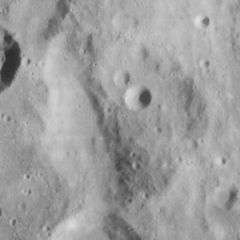Young (crater)
Young is a lunar impact crater that is located in the rugged southeast part of the Moon's near side. It lies to the east of the crater Metius, and southeast of Rheita. The long Vallis Rheita follows a line tangential to the southwest rim of Rheita, and cuts a wide trough through the southwest floor and outer rim of Young.
 Lunar Orbiter 4 image | |
| Coordinates | 41.5°S 50.9°E |
|---|---|
| Diameter | 71 km |
| Depth | 4.2 km |
| Colongitude | 310° at sunrise |
| Eponym | Thomas Young |
The surviving part of the crater is a worn, eroded formation that has seen better times. The rim and inner wall can still be followed across the surface, but it is indented and notched by smaller impacts. The inner floor contains a pair of small, bowl-shaped craters designated Young A and Young B.
To the south of Young, the valley is overlain by Young D, a somewhat less eroded feature than Young. The valley continues intermittently to the southeast, spanning a total distance of about 500 kilometers. This is the longest valley on the near side of the Moon.
Satellite craters
By convention these features are identified on lunar maps by placing the letter on the side of the crater midpoint that is closest to Young.
| Young | Latitude | Longitude | Diameter |
|---|---|---|---|
| A | 41.1° S | 51.2° E | 13 km |
| B | 40.9° S | 50.6° E | 7 km |
| C | 41.5° S | 48.2° E | 30 km |
| D | 43.5° S | 51.8° E | 46 km |
| F | 44.8° S | 51.8° E | 23 km |
| R | 42.4° S | 55.4° E | 9 km |
| S | 43.3° S | 53.9° E | 11 km |
References
- Andersson, L. E.; Whitaker, E. A. (1982). NASA Catalogue of Lunar Nomenclature. NASA RP-1097.CS1 maint: ref=harv (link)
- Blue, Jennifer (July 25, 2007). "Gazetteer of Planetary Nomenclature". USGS. Retrieved 2007-08-05.CS1 maint: ref=harv (link)
- Bussey, B.; Spudis, P. (2004). The Clementine Atlas of the Moon. New York: Cambridge University Press. ISBN 978-0-521-81528-4.CS1 maint: ref=harv (link)
- Cocks, Elijah E.; Cocks, Josiah C. (1995). Who's Who on the Moon: A Biographical Dictionary of Lunar Nomenclature. Tudor Publishers. ISBN 978-0-936389-27-1.CS1 maint: ref=harv (link)
- McDowell, Jonathan (July 15, 2007). "Lunar Nomenclature". Jonathan's Space Report. Retrieved 2007-10-24.CS1 maint: ref=harv (link)
- Menzel, D. H.; Minnaert, M.; Levin, B.; Dollfus, A.; Bell, B. (1971). "Report on Lunar Nomenclature by the Working Group of Commission 17 of the IAU". Space Science Reviews. 12 (2): 136–186. Bibcode:1971SSRv...12..136M. doi:10.1007/BF00171763.CS1 maint: ref=harv (link)
- Moore, Patrick (2001). On the Moon. Sterling Publishing Co. ISBN 978-0-304-35469-6.CS1 maint: ref=harv (link)
- Price, Fred W. (1988). The Moon Observer's Handbook. Cambridge University Press. ISBN 978-0-521-33500-3.CS1 maint: ref=harv (link)
- Rükl, Antonín (1990). Atlas of the Moon. Kalmbach Books. ISBN 978-0-913135-17-4.CS1 maint: ref=harv (link)
- Webb, Rev. T. W. (1962). Celestial Objects for Common Telescopes (6th revised ed.). Dover. ISBN 978-0-486-20917-3.CS1 maint: ref=harv (link)
- Whitaker, Ewen A. (1999). Mapping and Naming the Moon. Cambridge University Press. ISBN 978-0-521-62248-6.CS1 maint: ref=harv (link)
- Wlasuk, Peter T. (2000). Observing the Moon. Springer. ISBN 978-1-85233-193-1.CS1 maint: ref=harv (link)